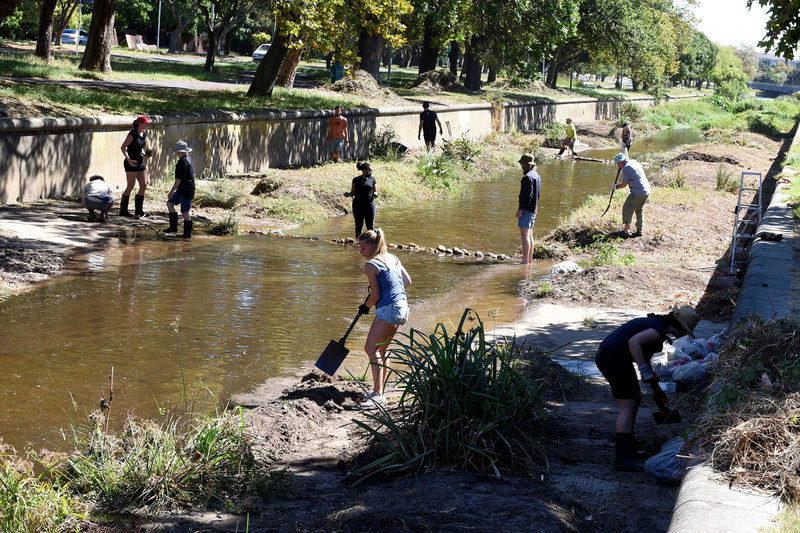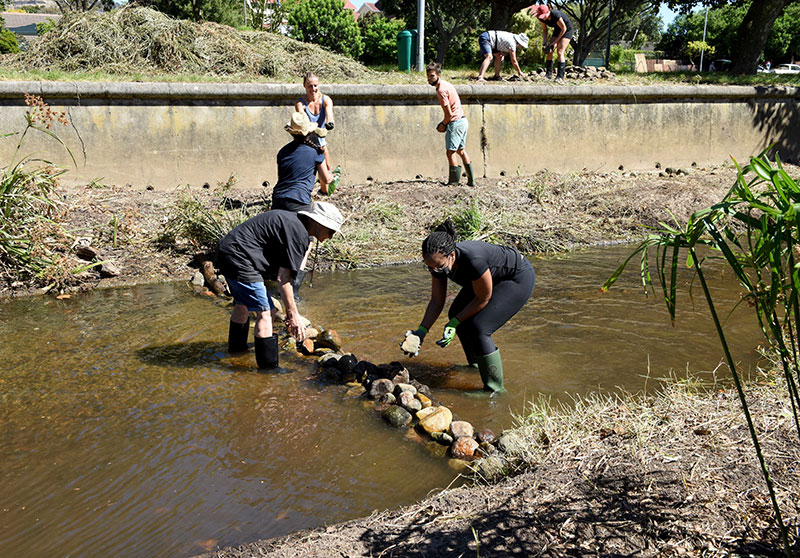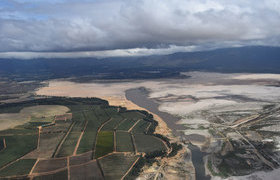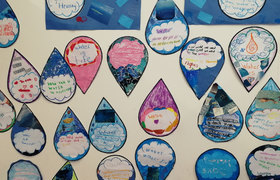UCT staff and students join ‘successful’ Liesbeek River clean-up
28 February 2022 | Story Niémah Davids. Photos Nasief Manie. Read time 6 min.
A massive clean-up operation along the Liesbeek River attracted dozens of eager University of Cape Town (UCT) staff and students, and local residents who hauled out their gardening tools and sacrificed a sunny Saturday morning to do their bit for the environment.
The clean-up operation is an initiative of Friends of the Liesbeek – a community-based non-profit organisation, established in 1991 and dedicated to rehabilitating, conserving and enhancing the Liesbeek River and its surrounds. The clean-up initiative, underway in the Rosebank canal section of the river, was carried out in partnership with UCT’s Future Water Institute, the Dutch Consulate in Cape Town, the City of Cape Town and Rosebank residents.
“The Liesbeek River provides a remarkable blue-green corridor that enhances the urban environment, cools soaring urban temperatures by as much as 5oC, and improves the natural habitat that attracts nature back into the city,” said Dr Kevin Winter, a senior lecturer in UCT’s Department of Environmental and Geographical Science.
UCT News caught up with Dr Winter after the clean-up. He offered some insights on the initiative and why it’s so important.
Niémah Davids (ND): What sparked this Liesbeek River clean-up?
Kevin Winter (KW): Cape Town’s water crisis a few years ago was a stark reminder that water scarcity is a real concern and that the city is highly dependent on rainfall for its water resources. As we continue to pick up the pieces after that devastating drought, we now need to focus on how to diversify our future water supply and how best to ensure that water quality is not compromised. In the process, we are learning to value water not only for its uses, but [also] to appreciate the value of surface- and groundwater.
“The Liesbeek River clean-up forms part of the City of Cape Town’s Liveable Urban Programme that seeks to improve urban areas around waterways and water quality in canals and rivers.”
The Liesbeek River clean-up forms part of the City of Cape Town’s Liveable Urban Programme that seeks to improve urban areas surrounding waterways and water quality in canals and rivers.
The latest project, launched as a pilot programme, was carried out in the Liesbeek Rosebank canal. Its aim is to provide a living laboratory and serve as an example of how a canalised section of a river can be converted back into a river, without it being massively expensive or causing a flood risk. If this project succeeds, we plan to roll it out to other parts of the Liesbeek River, as well as other parts of the city too. If rivers are able to cool down the city and bring nature back into the city, then this will be a worthwhile outcome.

ND: What are some of the many aims of this initiative?
KW: Hands down we want to improve the condition of the Liesbeek River, and one way of doing that is to convert those canalised sections back into the river.
Ten years ago, the Friends of the Liesbeek noticed how sediment had collected in the Rosebank canal section of the river. Soon thereafter, seeds that were embedded in the soil began to sprout, and over time the river began to meander, which means that it was no longer a straight channel. Consequently, the river started to attract and support a habitat of aquatic species, including Cape Galaxias – a small fish that lives in clear water in the upper reaches of the Liesbeek River. The presence of the fish and other species gave us a new understanding of how a canal could support ecological systems and address the misconception that the Liesbeek River is merely a stormwater channel.
ND: Tell us what this clean-up operation entailed.
KW: Initially, the Friends of the Liesbeek’s maintenance project team started this clean-up by removing weeds and grass along the 100 m stretch of the canal. Today [Saturday], residents of Rosebank and UCT staff and students volunteered their time to landscape the sediment mounds, which were left exposed by the initial weeding.
“This is a perfect example of what happens when people come together to do their bit for the environment.”
Volunteers also helped to set up rocky weirs to slow the water flow and to shift the water toward the edges of the canal. This process will ensure that the soil is kept moist to plant about 1 500 palmiet reeds and other riverine species. These plants will play an important role in stabilising the riverbed and will encourage macroinvertebrates and aquatic species to develop even further.
ND: What kind of interest has the community shown in this project?
KW: We’ve had an overwhelming response from the community. This project has captured the interest and imagination of so many. Many UCT students were involved in the clean-up, and some are using this exercise to build their own research projects. One thing that was abundantly clear during the clean-up: volunteers were extraordinarily positive and wanted to make a difference by working together. We need to create more opportunities like this to enable citizens to make a difference.
Of interest too is the wonderful role that community groups like the Friends of the Liesbeek [play] to draw on the strengths and expertise of local residents, students and UCT academics who are skilled in urban water management and restoration work, to contribute to this project. This is a perfect example of what happens when people come together to do their bit for the environment and understand the value of working together.
 This work is licensed under a Creative Commons Attribution-NoDerivatives 4.0 International License.
This work is licensed under a Creative Commons Attribution-NoDerivatives 4.0 International License.
Please view the republishing articles page for more information.










